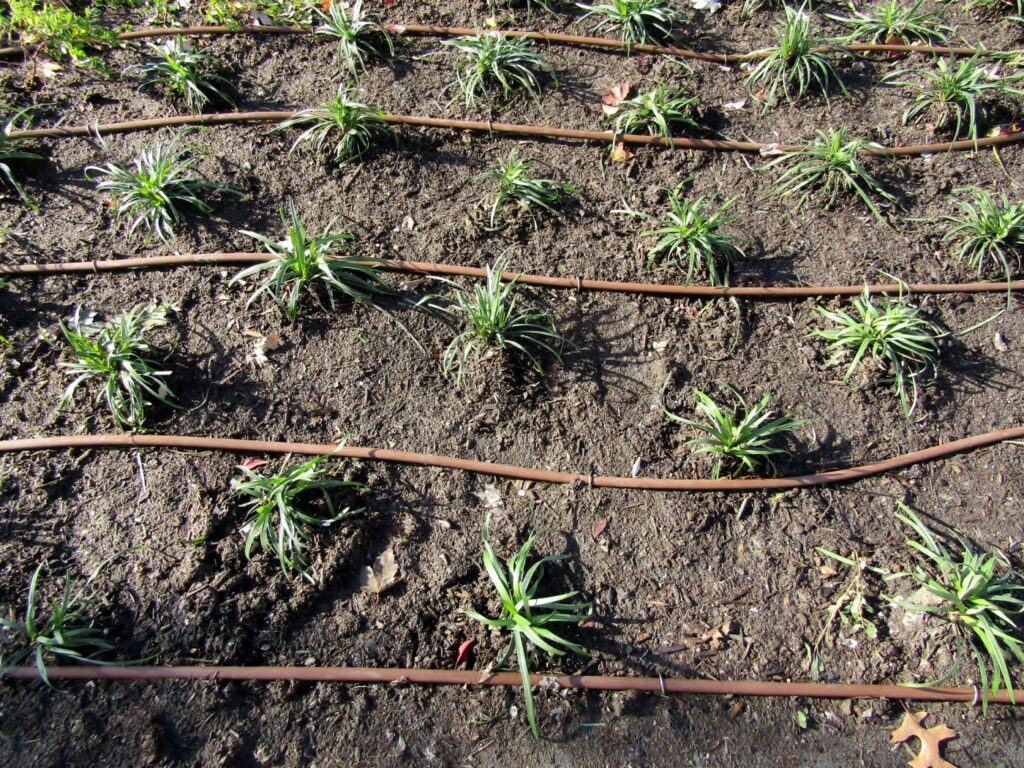
1. If you are planting a new garden or evaluating an existing one this spring in terms of its water needs, consider drip irrigation options. You can now acquire underground drip tubing for around 50 cents a foot. Emitters are embedded in the tubing at 12 or 18-inch spacing. With such a system, evaporative water loss is nullified and water savings are profound. Such an application is especially pertinent to parkway strips where, if you want to go with drip everywhere, above-ground tubing would be exposed to foot traffic and could be a trip hazard. On the bottom third of a slope, however, to avoid puddling, increase dripline spacing by 25% and make that area a separate irrigation zone. When it comes to conventional drip tubing, you can acquire rolls of it with embedded emitters (25 cents a foot) or smooth tubing (10 cents a foot) where you make holes and insert the drip emitters yourself, according to the placement of your plants. From my experience, embedded emitters make more sense since most gardens are full enough of plants to support consistent emitter spacing. Leakage can also be a problem when punching holes and inserting emitters yourself.
2. Plant hellebores now for something different for partial shade. Flowers are white or understated yellow, pink, violet, or burgundy, and all fade to green, while foliage is blue-green. In the words of Barry Glick, the world’s foremost hybridizer and grower of hellebores: “Even if you believe you are cursed with a ‘Black Thumb,’ you will succeed with hellebores. That’s how easy they are. Not only will they grace your table with beautiful cut flowers, they’ll still be thriving when they plant you in the ground.” Go to sunfarm.com to select your hellebores and choose from a large variety of other uncommon garden selections.
3. Now is a good time to start your own pineapple project. Here are instructions from Joseph Ortega, who gardens in San Pedro. “Cut off the clump of green leaves on top of a pineapple and remove as much flesh as possible. Remove bottom leaves and you will see little white nubs from where roots grow. Let the cut area callus (dry and harden) for a few days before planting. Make a soil mix that is half orchid bark and half potting soil. Or you can use cactus mix. Place in a 6-inch pot with soil covering the area from where roots emerge. Keep lightly moist, mist often, and roots will be seen in 2-3 weeks. Since they feed through their leaves, a 15-30-15 fertilizer such as Grow More Super Bloomer, dissolved in water for a foliar spray, works well. Provide full sun, southern exposure. It takes 2-3 years for a pineapple to flower, fruit and mature. Our first one was as delicious as the ones in Hawaii.”
Pineapples, named for their resemblance to huge pine cones, originated in the Brazilian rain forest. They were brought to Europe and North America by sea voyagers in the 15th and 16th centuries and grown in heated greenhouses known as “pineries.” George Washington was among those who grew them in this manner. Pineapples were brought to Hawaii in the early 1800s. A hundred years later, 22-year-old James Dole arrived there and developed the first successful pineapple canning operation. By 1960, Hawaii grew 80% of the world’s pineapples, but today less than 1%, with Costa Rica, Brazil, and the Philippines the top three pineapple growers.
4. Fertilize azaleas and camellias after they finish flowering, but only if they need it. I have seen mature azaleas and camellias that never produce yellow leaves, the tell-tale sign of mineral deficiency. Consistent mulching of any plant will mitigate, if not eliminate, the need for fertilizing it. At the nursery, you will find fertilizers, if needed, specifically formulated for azaleas and camellias. Azaleas are sometimes negated as garden selections because of a reputation for water neediness. However, planted in peat moss, properly sited and well-mulched, azaleas are fully capable of existing on no more than two weekly soakings and can live for more than a hundred years. As for camellias, I have seen mature plants facing north where water was delivered no more than once a month. G. Brickner sent a photo of an Azalea var. Antoinette Martin, an impressive cultivar featuring white flowers marked with a thick rosy red stripe bisecting each petal. For a large selection of azaleas and camellias, visit Nuccio’s Nurseries in Altadena (nucciosnurseries.com).
5. Borage (Borago officinalis) is one of the most charming choices for spring planting. It is easy to grow from seed and develops into a whimsical plant up to three feet tall with clusters of hirsute reddish flower stems and buds that open into nodding blue, star-shaped flowers. It is a superior pollinator plant, attracting honey bees, bumble bees, and native bees. Borage leaves are edible and have the flavor of cucumber. Be careful that you eat only the very young leaves raw; older leaves are somewhat prickly and will stick in your throat unless they are cooked prior to consumption.
As your wildflowers bloom, you are encouraged to send photos along with their history to the email address below.
Please send questions, comments, and photos to joshua@perfectplants.com.
